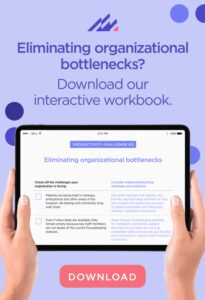Article
Three signs that bottlenecks are bringing down your organisation
If healthcare is an ecosystem, we might think of each healthcare organisation as an organism. Just as an organism can comprise many organ systems, most healthcare organisations have several departments and service lines. Each department performs a set of functions that enable the organisation to operate. While these departments may be distinct, they are also interconnected. A lapse in one department can affect an entire organisation—just as organ failure can compromise the entire health of an organism.
When we put a healthcare organisation under a microscope, we see how even the smallest delays can have downstream effects on patient flow. Here are three signs your own organisation may have a bottleneck problem.
Go with the flow
 One flag signaling that a hospital is dealing with patient flow disruptions is a phenomenon commonly referred to as “corridor healthcare” (also known as “hallway healthcare”). As the name suggests, corridor healthcare occurs when providers see patients in corridors (or other non-traditional locations within a facility) because there are no empty beds available. In addition to detracting from a patient’s experience, comfort and/or privacy, this can also increase the risk of patient safety issues like disease transmission. Contributors to this problem include a rise in accident and emergency (A&E) department visits, growth of the aging population with more complex care needs and staffing shortages.
One flag signaling that a hospital is dealing with patient flow disruptions is a phenomenon commonly referred to as “corridor healthcare” (also known as “hallway healthcare”). As the name suggests, corridor healthcare occurs when providers see patients in corridors (or other non-traditional locations within a facility) because there are no empty beds available. In addition to detracting from a patient’s experience, comfort and/or privacy, this can also increase the risk of patient safety issues like disease transmission. Contributors to this problem include a rise in accident and emergency (A&E) department visits, growth of the aging population with more complex care needs and staffing shortages.
Another symptom of bottlenecks is having a “cold bed” problem. This situation occurs when there are empty beds that go unused because staff members aren’t aware that those beds are actually available. A hospital may have cold beds if it uses manual processes to track housekeeping, for example, leading to a breakdown in communication on open beds. Many hospitals already deal with bed gridlock, and cold beds only make matters worse because they are simply going to waste.
A third sign that your organisation has preventable bottlenecks is a reliance on reactive decision-making. When leaders have to quickly assess current operational performance and make decisions on the fly, it is easy to misalign staffing and resources. But if leaders have a way to compare past trends to real-time data, they can make more informed decisions that speed up patient throughput instead of adding friction.
Planning for the future
As hospitals feel the squeeze of staffing shortages, financial pressures, supply chain issues and more, it is more important than ever to reduce waste and keep operations moving smoothly.
Do you have a sneaking suspicion that your organisation could have much better patient flow? Check out our new resource, “Pursuing peak productivity: A workbook for healthcare organizations,” that can help you assess where your organisation stands, learn strategies to reduce organisational bottlenecks and review other barriers potentially bringing down your organisation’s productivity. Learn more and download the workbook here.














